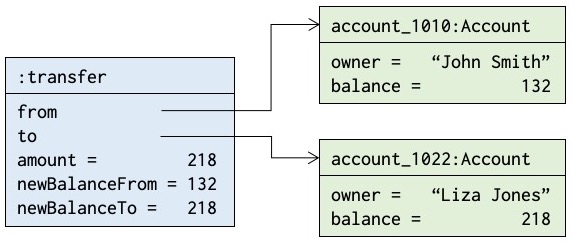In programming languages in general, a method is often called a procedure, or function. The term method was introduced by Smalltalk and has since then been used instead of procedure in OO languages. Sometimes the term function is used for a procedure that computes a value only based on its parameters.
Objects may have attributes in the form of methods. In the previous chapters, we have seen examples of methods such as addInterest, deposit and withdraw. Here we describe methods in more detail.
A method describes a sequence of statements to be executed. Execution of a statement results in some actions that may change the datums of data-items or compute new datums based on the datums of the data-items of the enclosing object and its possible parameters.
A method has the form:
MethodName(Parameters) ReturnValue: SuperMethod
Declarations
StatementsA method has a name as specified by MethodName.
A method may have parameters as specified by Parameters – if no parameters, the brackets are not needed. The Parameters may be one or more declarations of data-items or virtual classes and methods – see section .
In section and chapter , we have seen examples of methods deposit and withdraw that both have one parameter. In the next example we show an example of a method with two parameters:
transfer(from: ref Account, to ref Account, amount: var float):
from.withdraw(amount)
to.deposit(amount)A method may also specify a value to be returned by an invocation of the method – ReturnValue is the type of this value.
A method may also have a supermethod as specified by SuperMethod. A supermethod is similar to a superclass – we explain supermethods in section .
The body of a method consist of a sequence of possible declarations and statements as specified by Declarations and Statements.
The clause ReturnValue is either empty or has the form:
-> ReturnDeclarationwhere ReturnDeclaration may be a declaration of a variable (var or ref) data-item.
In chapter 2 and 3, the method withdraw is an example of a method with a return value:
withdraw(amount: var float) -> newB: var float:
balance := balance - amount
newB := balanceAs can be seen, a method has almost the same structure as a class. The only difference is that a return value may be specified. A class has an implicit return value, being a reference to an object of the class.
Method invocation
In Chapters 2 and 3, we have seen examples of execution — invocation, of methods. Below we show an invocation of transfer from the account of John Smith to the account of Liza Jones.:
transfer(account_1010,account_1022,218)In the next example, we have defined transfer within an object BankSys together with class Account and an instance of Account. We have modified deposit to also return the new balance.
BankSys: obj
class Account(owner: var String):
balance: var float
-"-
deposit(amount: var float) -> newB: var float:
-"-
withdraw(amount: var float) -> newB: var float:
-"-
transfer(from: ref Account, to ref Account, amount: var float):
newBalanceFrom, newBalanceTo: var float
newBalanceFrom := from.withdraw(amount)
newBalanceTo := to.deposit(amount)
account_1010: obj Account("John Smith")
account_1022: obj Account("Liza Jones")
account_1010.deposit(350)
transfer(account_1010, account_1022, 218)The transfer method has two local data-items newBalanceFrom and newBalanceTo, which are assigned the new values of balance of from and to respectively.
In addition to the declarations of BankSys, we have added statements that are executed by BanksSys:
account_1010: obj Account("John Smith")
account_1022: obj Account("Liza Jones")
account_1010.deposit(350)
transfer(account_1010, account_1022, 218)A method invocation creates a method object that has the structure specified the method. The method object contains possible parameters and possible data-items of the method.
The following snapshot shows the situation at the end of execution of the transfer method object:
transfer(from: ref Account, to ref Account, amount: var float):
newBalanceFrom, newBalanceTo: var float
newBalanceFrom := from.withdraw(amount)
newBalanceTo := to.deposit(amount)
-->
As mentioned in section , the initial value of balance is 0 (zero), which means that before transfer is executed account_1010.balance is 350 and account_2022.balance is 0 (zero).
A method object is sometimes called a method invocation or just invocation.
There is a strong similarity between method invocation and method object on the one side and class instantiation and object on the other side. Both forms of invocation/instantion create an object and starts executing the statements of the object.
The object (class object or method object) executing a method instantiation is denoted the invoker and the method object is sometimes denoted the callee.
Again, we may see that a method invocation is quite similar to a class instantiation. The difference in wording between invocation and instantiation is that for a method, invocation emphasizes that execution of statements is the primary task. For a class, instantiation emphasise that creation of an object is the primary task.
